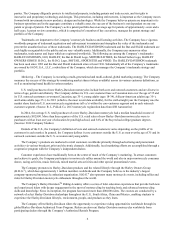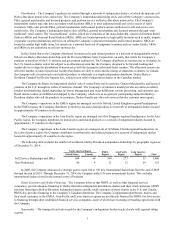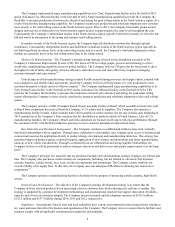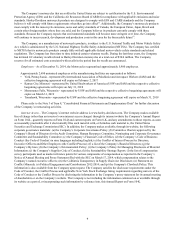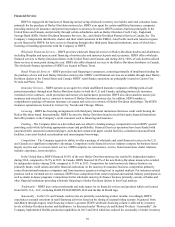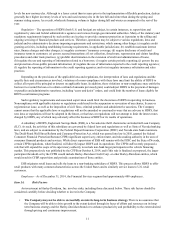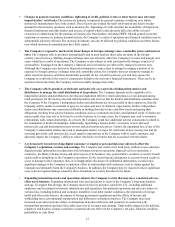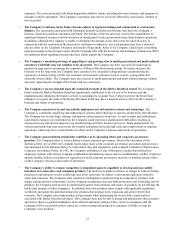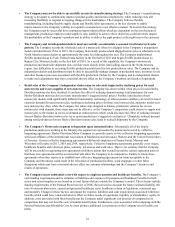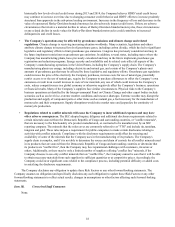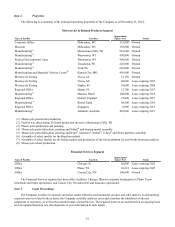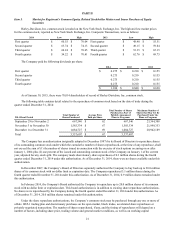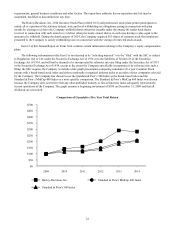Harley Davidson 2014 Annual Report Download - page 16
Download and view the complete annual report
Please find page 16 of the 2014 Harley Davidson annual report below. You can navigate through the pages in the report by either clicking on the pages listed below, or by using the keyword search tool below to find specific information within the annual report.
• The Company may not be able to successfully execute its manufacturing strategy. The Company’s manufacturing
strategy is designed to continuously improve product quality and increase productivity, while reducing costs and
increasing flexibility to respond to ongoing changes in the marketplace. The Company believes flexible
manufacturing, including flexible supply chains and flexible labor agreements, is the key element to enable
improvements in the Company’s ability to respond to customers in a cost effective manner. To execute this strategy,
the Company must be successful in its continuous improvement efforts which are dependent on the involvement of
management, production employees and suppliers. Any inability to achieve these objectives could adversely impact
the profitability of the Company’s products and its ability to deliver the right product at the right time to the customer.
•The Company and its independent dealers must successfully accommodate a seasonal retail motorcycle sales
pattern. The Company records the wholesale sale of a motorcycle when it is shipped to the Company’s independent
dealers and distributors. Prior to 2013, the Company historically produced and shipped motorcycles at wholesale to its
North America region dealers at approximately the same level throughout the year. The Company implemented
flexible production at its York, Pennsylvania facility in the first half of 2013 and began flexible production at its
Kansas City, Missouri facility in the first half of 2014. As a result of this capability, the Company's motorcycle
production and wholesale shipments now correlate more closely to the retail selling season in the North America
region. Any difficulties in executing flexible production could result in lost production or sales. The Company and its
independent dealers and distributors must be able to successfully manage changes in production rates, inventory levels
and other business processes associated with flexible production. Failure by the Company and its independent dealers
to make such adjustments may have a material adverse effect on the Company’s business and results of operations.
•Retail sales of the Company’s independent dealers may be adversely impacted by declining prices for used
motorcycles and excess supplies of new motorcycles. The Company has observed that when prices for used Harley-
Davidson motorcycles have declined, it can have the effect of reducing demand among retail purchasers for new
Harley-Davidson motorcycles (at or near manufacturer’s suggested retail prices). Further, introduction of new
motorcycle models with significantly different functionality, technology or other customer satisfiers can result in lower
customer demand for used motorcycles, resulting in declining prices for those used motorcycles, and prior model-year
new motorcycles. Also, while the Company has taken steps designed to balance production volumes for its new
motorcycles with demand, those steps may not be effective, or the Company’s competitors could choose to supply new
motorcycles to the market in excess of demand at reduced prices which could also have the effect of reducing demand
for new Harley-Davidson motorcycles (at or near manufacturer’s suggested retail prices). Ultimately, reduced demand
among retail purchasers for new Harley-Davidson motorcycles leads to reduced shipments by the Company.
•The Company’s Motorcycles segment is dependent upon unionized labor. Substantially all of the hourly
production employees working in the Motorcycles segment are represented by unions and covered by collective
bargaining agreements. Harley-Davidson Motor Company is currently a party to five collective bargaining agreements
with local affiliates of the International Association of Machinists and Aerospace Workers and the United Steelworkers
of America. Current collective bargaining agreements with hourly employees in Pennsylvania, Missouri and
Wisconsin will expire in 2017, 2018 and 2019, respectively. Collective bargaining agreements generally cover wages,
healthcare benefits and retirement plans, seniority, job classes and work rules. There is no certainty that the Company
will be successful in negotiating new agreements with these unions that extend beyond the current expiration dates or
that these new agreements will be on terms that will allow the Company to be competitive. Failure to renew these
agreements when they expire or to establish new collective bargaining agreements on terms acceptable to the
Company and the unions could result in the relocation of production facilities, work stoppages or other labor
disruptions which may have a material adverse effect on customer relationships and the Company’s business and
results of operations.
•The Company incurs substantial costs with respect to employee pension and healthcare benefits. The Company’s
cash funding requirements and its estimates of liabilities and expenses for pensions and healthcare benefits for both
active and retired employees are based on several factors that are outside the Company’s control. These factors include
funding requirements of the Pension Protection Act of 2006, the rate used to discount the future estimated liability, the
rate of return on plan assets, current and projected healthcare costs, healthcare reform or legislation, retirement age
and mortality. Changes in these factors can impact the expense, liabilities and cash requirements associated with these
benefits which could have a material adverse effect on future results of operations, liquidity or shareholders’ equity. In
addition, costs associated with these benefits put the Company under significant cost pressure as compared to its
competitors that may not bear the costs of similar benefit plans. Furthermore, costs associated with complying with the
Patient Protection and Affordable Care Act may produce additional cost pressure on the Company and its health care
plans.
16


